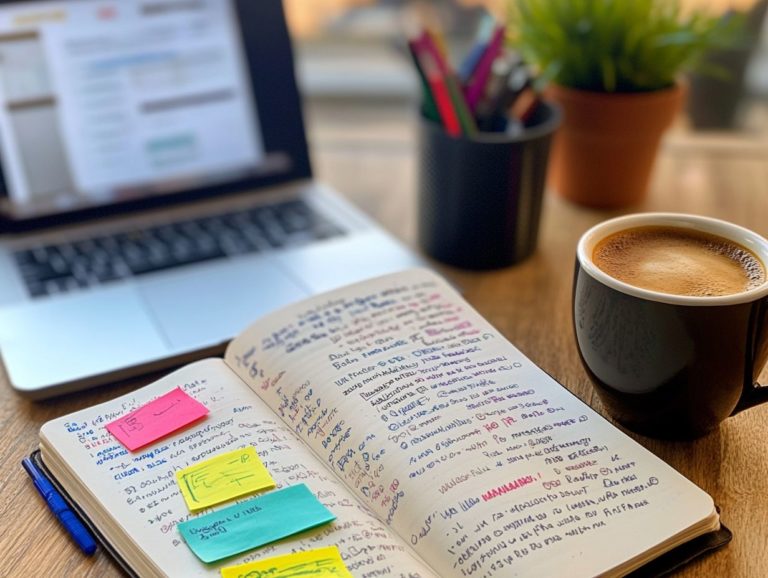5 Most Effective Language Learning Methods
Learning a new language can be an exhilarating yet intimidating experience. With many methods at your disposal, it s crucial to discover the strategies that resonate most effectively with you.
This article delves into five powerful approaches: immersion, conversational practice, spaced repetition, gamification, and the use of audio and visual aids. Each method presents unique benefits along with practical tips to enrich your language-learning journey.
Whether you re just starting out or aiming to polish your skills, these strategies are designed to help you navigate challenges and attain fluency with confidence.
Contents
- Key Takeaways:
- 1. Immersion
- 2. Conversational Practice
- 3. Spaced Repetition
- 4. Gamification
- 5. Audio and Visual Aids
- What Are the Benefits of Learning a Language Through Immersion?
- How Can One Incorporate Immersion into Their Language Learning?
- What Are the Advantages of Conversational Practice in Language Learning?
- How Can One Find Conversational Practice Partners?
- What Is Spaced Repetition and How Does It Help with Language Learning?
- How Can One Use Spaced Repetition in Their Language Learning?
- What Are the Benefits of Using Gamification in Language Learning?
- What Are Some Examples of Gamification in Language Learning?
- How Do Audio and Visual Aids Enhance Language Learning?
- What Are Some Recommended Audio and Visual Aids for Language Learning?
- What Are the Common Challenges of Language Learning and How Can These Methods Help Overcome Them?
- Frequently Asked Questions
- Curious about the best language learning methods?
- How does immersion help with language learning?
- What is spaced repetition and how does it aid in language learning?
- Why are grammar drills important in language learning?
- How does conversation practice benefit language learners?
- What is cultural immersion and why is it beneficial for language learning?
Key Takeaways:

1. Immersion
Immersion is essential in language learning. It provides an engaging environment for you to naturally absorb the language.
This method helps your brain learn better through constant exposure and interaction with native speakers. It fuels your motivation and improves your language skills.
Techniques like learning by doing and practicing conversations enable you to use the language in real-life scenarios. For example, imagine yourself in a local cooking class where only Spanish is spoken. You’d be surrounded by culinary vocabulary and cultural nuances, which complements quick tips for language learners on a budget.
If you re learning French, you might engage in conversation exchanges with native speakers at a caf . This allows you to practice in authentic contexts.
Immersive theater experiences can thrust you into dialogues that challenge and elevate your fluency. These experiences highlight the importance of a supportive learning environment that nurtures your growth and encourages genuine interactions.
2. Conversational Practice
Conversational practice is a cornerstone of language learning. It gives you invaluable opportunities to engage directly with native speakers.
This not only enhances your fluency but also builds your confidence. Active engagement reinforces your vocabulary while allowing you to grasp the nuances, slang, and rhythm of everyday speech elements that often go unnoticed in traditional classrooms.
To fully leverage these advantages, seek out suitable conversation partners through language exchange websites, local meetups, or even social media platforms.
Establishing regular practice sessions, perhaps a couple of times each week, will create a routine that nurtures your improvement.
By emphasizing active learning during these discussions asking open-ended questions, practicing active listening, and offering feedback you can significantly enhance your speaking abilities while cultivating a richer understanding of the language.
3. Spaced Repetition
Spaced repetition is a powerful learning strategy that can significantly enhance your vocabulary retention and recall.
By revisiting material at strategically spaced intervals, it becomes an essential technique in your language-learning journey.
This method works with your brain s natural learning patterns, allowing you to strengthen neural connections and vastly improve your recall abilities.
When you use tools like flashcards or popular language learning apps, you can efficiently review previously learned vocabulary and grammar points, optimizing your study time.
To create a personalized spaced repetition schedule, assess your own learning pace and adjust the intervals based on how easily you retain information.
Regularly updating your flashcards and incorporating multimedia elements can elevate your engagement and retention throughout the learning process.
4. Gamification
Gamification uses game-like features to make learning more fun. It elevates motivation and engagement by transforming the process into a delightful journey filled with rewards, challenges, and interactive activities.
This innovative approach taps into your natural desire for achievement and recognition, redefining traditional instructional methods. Think about popular language learning apps like Mango and Busuu. They seamlessly integrate features such as points, levels, and leaderboards to make studying effective, inviting, and competitive.
You ll find yourself driven to practice regularly, not just to progress through levels, but also to earn badges that celebrate your accomplishments. To embrace gamification in your self-directed language learning, set personal challenges and create reward systems for reaching milestones. Engage with peers through friendly competitions to foster a dynamic and enjoyable learning environment.
5. Audio and Visual Aids
Audio and visual aids are essential tools in your language learning journey. They enhance your listening comprehension and provide engaging experiences that facilitate effective communication and a deeper understanding of cultural contexts.
These resources cater to diverse learning styles and engage you dynamically, making the process not just effective but also enjoyable. For instance, incorporating music can refine your pronunciation and rhythm. Additionally, exploring 5 online courses for language learning can enhance your skills, while films immerse you in conversational nuances and cultural references within a vivid context.
Educational videos simplify complex ideas into manageable segments, supporting your gradual learning.
To fully leverage these aids, consider platforms such as:
- Duolingo for bite-sized lessons,
- Netflix, with its extensive catalog of foreign films and series, significantly enhances your reading and listening skills in an authentic setting.
What Are the Benefits of Learning a Language Through Immersion?

Learning a language through immersion offers you a wealth of benefits. It sharpens your language skills and deepens your understanding of cultural nuances, all of which contribute to better communication and retention.
Students like you who engage in immersion programs often find themselves more motivated to learn. Real-world contexts require active participation, fostering fluency and a genuine appreciation for diverse cultures as you interact with native speakers.
Research published in the “Journal of Educational Psychology” shows that individuals in immersive environments experience significant advancements in vocabulary acquisition and conversational skills compared to their peers in traditional classrooms.
Studies from the “Modern Language Journal” highlight the lasting effects of immersion on your thinking skills and problem-solving abilities, reinforcing the idea that such educational methods cultivate enriched and multifaceted language experiences.
How Can One Incorporate Immersion into Their Language Learning?
Incorporating immersion into your language learning journey can be achieved through various strategies. For instance, consider 5 tips for learning a language while traveling, engage in mobile-assisted learning, and participate in activities that focus on real-life tasks. Surround yourself with the target language in your daily life.
You can enhance your experience by utilizing language learning apps that offer interactive exercises and real-life scenarios, fostering practical application. Attending language meetups provides invaluable opportunities to converse with native speakers, reinforcing your skills in a supportive environment.
You can also consume movies, music, and books in your target language. This creates an immersive atmosphere that boosts your comprehension and deepens your cultural understanding. Such experiences encourage you to practice regularly, enhancing retention and making the language feel more intuitive in your life.
What Are the Advantages of Conversational Practice in Language Learning?
Conversational practice offers substantial benefits in language learning. It improves your speaking skills, boosts your confidence, and provides opportunities to learn directly from native speakers.
This dynamic approach enriches your educational experience and makes it far more engaging. When you engage in regular dialogue, you enhance your vocabulary and pronunciation while immersing yourself in authentic contexts that sharpen your comprehension.
Participating in language exchange programs or using online platforms that connect you with native speakers allows you to practice in environments that closely resemble real-life interactions. Such experiences promote active learning, ensuring that lessons resonate more profoundly.
The motivational spark of conversing with someone fluent can ignite your passion for improvement. This ultimately paves the way for greater fluency and a richer understanding of cultural nuances.
How Can One Find Conversational Practice Partners?
Finding conversational practice partners can greatly enhance your language learning experience. Various methods, such as using mobile devices and exploring online communities, make this process more accessible than ever.
Start exploring language exchange apps today to connect with native speakers eager to practice their language. Joining social media groups dedicated to language enthusiasts can open up a treasure trove of opportunities for engaging conversations.
Don t overlook local meetups or language cafes, which provide excellent venues for in-person interactions that build your confidence. It s crucial to stay motivated and integrate consistent practice into your routine.
Regular conversations solidify your vocabulary and grammar while helping you develop a more authentic accent. Get excited you re on the fast track to fluency!
What Is Spaced Repetition and How Does It Help with Language Learning?
Spaced repetition is a learning technique designed to improve your vocabulary retention. This method strategically spaces out your reviews of learned material, ensuring that your cognitive processes are finely tuned for long-term memory.
This technique is based on principles from cognitive science, which studies how our brain learns. It incorporates the forgetting curve, which reveals how information gradually slips away without reinforcement.
By timing your reviews just before you start to forget, you can dramatically boost your retention rates. In language learning, this means revisiting vocabulary at intervals that foster a deeper understanding rather than cramming.
Tools like Anki and Memrise excel in this technique, using algorithms that schedule your flashcard reviews based on your progress. This makes it easy for you to expand your vocabulary effectively and confidently.
How Can One Use Spaced Repetition in Their Language Learning?
To harness the power of spaced repetition, consider integrating tools like flashcards and quizzes that extend the intervals between your reviews. This approach optimizes your retention and recall of vocabulary.
By choosing apps designed for spaced repetition, you can tailor your study sessions to match your unique progress and comfort levels. These tools let you monitor your performance, pinpointing areas where you struggle or shine.
With this insightful data, you can adjust your review intervals accordingly. Revisit challenging words more frequently while spacing out easier terms.
Adopting this adaptive learning strategy streamlines your study process and enhances your engagement. You ll feel a rewarding sense of accomplishment as you reach your milestones.
What Are the Benefits of Using Gamification in Language Learning?

Gamification in language learning offers a wealth of benefits, including heightened motivation, increased engagement, and the ability to track your progress. This approach makes learning more fun by using game-like mechanics.
You can achieve these benefits by using elements like points, badges, and leaderboards. These features encourage friendly competition and promote consistent practice.
Academic studies, including those published in the “Journal of Educational Psychology,” reveal that game-based techniques significantly enhance retention and comprehension.
Language learning apps such as Duolingo and Babbel perfectly illustrate this trend with their integration of levels and reward systems, helping you stay committed to your learning objectives. Features like timed challenges and social sharing further enrich the interactive experience, allowing you to progress at your own pace while basking in a well-deserved sense of accomplishment.
What Are Some Examples of Gamification in Language Learning?
Examples of gamification in language learning are all around you, especially in popular apps like Mango and Busuu. These platforms cleverly incorporate points, levels, and challenges to motivate you and enhance your learning experience.
These apps utilize engaging features such as reward systems, allowing you to earn badges for completing lessons or reaching milestones, providing that gratifying sense of accomplishment. Leaderboards add a layer of friendly competition, letting you gauge your progress against friends or fellow learners worldwide, which fuels your motivation through social engagement.
Interactive lessons often feature quizzes and mini-games that turn vocabulary practice and grammar drills into enjoyable activities rather than mundane tasks. Collectively, these elements create a dynamic learning environment that boosts language proficiency while keeping you fully engaged.
How Do Audio and Visual Aids Enhance Language Learning?
Audio and visual aids elevate your language learning experience by providing contextual and engaging materials that enhance listening comprehension, reading practice, and overall language understanding.
These tools make your studies exciting and lively, making it easier for you to grasp complex vocabulary and grammar structures. For instance, podcasts immerse you in native speech patterns and accents, while videos illustrate cultural contexts, enabling you to connect more deeply with the language.
Similarly, infographics distill intricate concepts into memorable visuals that bolster retention. Using different audio and visual resources makes learning exciting. It helps you engage with the language meaningfully and stay motivated.
What Are Some Recommended Audio and Visual Aids for Language Learning?
Regarding language learning, you’ll want to tap into a variety of audio and visual aids that truly elevate your experience. Consider utilizing 5 tips for staying engaged, along with resources like podcasts, documentaries, and specialized language-learning platforms that offer immersive and effective methods for honing your reading and listening skills.
Take popular platforms like Duolingo and Babbel, for instance. They provide interactive lessons that seamlessly blend audio prompts with visual cues, making your learning journey both engaging and practical.
Websites such as FluentU take it a step further by using real-world videos music videos and movie trailers included to enhance your comprehension and retention, allowing you to absorb authentic language in context.
Don t overlook YouTube channels dedicated to language tutorials, as they introduce you to a rich tapestry of accents and dialects. By integrating these resources into your daily study routine perhaps dedicating 30 minutes to watch an episode of a show in your target language or listening to a language-specific podcast during your commute you can significantly elevate your fluency and conversational prowess.
Try out these resources today and see how they boost your learning!
What Are the Common Challenges of Language Learning and How Can These Methods Help Overcome Them?
Common challenges in language learning often include low motivation, difficulty in retaining vocabulary, and a lack of practice opportunities. You can significantly overcome these hurdles by employing effective methods such as immersion, conversational practice, and 5 steps to enhance your language learning experience like spaced repetition.
Many learners struggle to recall newly acquired vocabulary due to infrequent usage, leading to frustration and lowered confidence. Using spaced repetition can supercharge your memory and make vocabulary stick by revisiting words at specific intervals. Immersing yourself in media consumption whether through watching films or listening to music in your target language exposes you to real-life usage and cultural context, making the learning process more engaging.
A language partner can help you practice speaking and listening skills while cultivating a sense of community and accountability. This dynamic reignites your motivation and provides invaluable feedback, making your journey toward fluency more rewarding.
Frequently Asked Questions
Curious about the best language learning methods?

- Immersion
- Spaced repetition
- Grammar drills
- Conversation practice
- Cultural immersion
How does immersion help with language learning?
Immersion surrounds you with the language and integrates it into daily life, leading to natural learning and improved fluency.
What is spaced repetition and how does it aid in language learning?
Spaced repetition is the practice of reviewing material at increasing intervals, which facilitates better retention and long-term learning.
Why are grammar drills important in language learning?
Grammar drills teach the rules and structure of a language, making communication easier.
How does conversation practice benefit language learners?
Conversation practice helps develop speaking and listening skills for more natural and confident communication.
What is cultural immersion and why is it beneficial for language learning?
Cultural immersion involves engaging with the culture of the language being learned, enhancing understanding and appreciation of its nuances.
Start using these methods today to boost your language learning journey!





